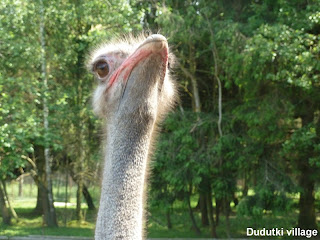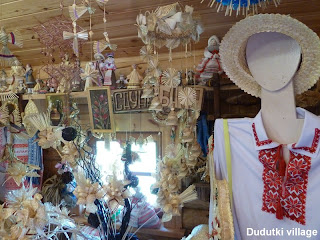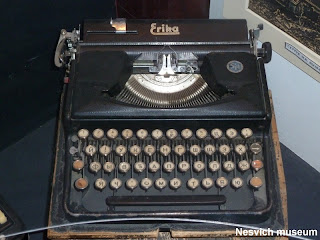Hi Friends,
week no5 was relatively eventless,
except for a very pleasant and interesting dinner on Monday with Bernd
Rosenberg. He explained me some of the intricacies of the Belarussian economic
system which still in many parts has not developed much from the planned
economy. The system is still subsidizing fuel and basic food items and there
exists an intricate system of also subsidizing utilities and apartment block
running costs. There also is a system of helping qualified people acquiring
their first apartment with basically interest free financing. On the other hand
there is practically no financing available for any other private investment
(prohibitively high interest rates). This is one of the explanations for me why
the general populace, while not rich, is able to survive on a relative decent
level.
My Yamaha also continues to give me
electrical headaches. After the dead battery 3 weks ago some short circuit
developed which intermittently made my speedometer/combi instrument crash. So
it took from Monday morning till Wednesday evening and USD 90 till they found
an apparently broken cable… and tonight the battery again was flat… so it seems
there is still something wrong…
But I can’t fill my blog with that
stuff else you stop reading it… That’s why I decided that yesterday I had to go
to Dudutki village, an open air museum of high reputation in the country. It’s
about 40 kms from here and as the weather forecast was bad I didn’t take the
Yamaha but the motorhome plus bicycle (which in the end I didn’t use anyway).
Here a link for those of you interested: http://www.dudutki.com/
It was a large farm in the 19th
century and an originally Lithuanian writer and businessman Eugene Budinas in
1994 somehow had the vision to establish it and revive some of the old
traditions and handicrafts. Certainly, critics will say it has elements of
kitsch, maybe, but it still enables people to get some feel for their roots.
And considering by the amount of busses and people I saw there, it works. And,
I must say, it worked for me. There was even a future teller who called me as I
was passing and although she didn’t look very professional (pretty and in her
20s) I gave in as she wasn’t deterred by my confession not to speak Russian but
told me my future in detail and in accent free German (well, not quite, with an
distinctly “German” accent). I’ll leave out the details but it was bright and
finally it turned out that she was studying at the same university as I’m
presently taking my classes…
Obviously, the apparently only
collection of (sort of) antique cars in BY is also there and caused my
interest. Well, that would not be the reason for me to come back for although
one early Moskvitch caught my eye, less so for it’s condition but for the fact
that it must have been one of the first Opel Kadetts produced on the demounted
machinery from Eisenach and reassembled by German prisoners of war in Moscow in
about 1946 or 7.
http://en.wikipedia.org/wiki/Moskvitch
The promised Horch was nowhere to be
seen so I think it might have been sold, or hopefully is being or has been
restored. A fate, which I would wish for the other exhibition objects too as
they mostly were in a quite dilapidated state.
Dudutki now even has its own
attractive new wooden orthodox church.
But the real interesting part started
only after leaving it. It was early afternoon and I intended to use my map and
navigate to Nesvizh castle. Now like with ways to Rome it is with Nesvizh. There are many ways
there, or so I thought. All of you who know me well, know that I prefer the off
beaten tracks… So I decided to what I considered the “Diretissima” also because
I intended to have a look at the “real” BY. That much right away: yes, I did.
The main roads are like in Austria and so are the regional
roads. Well, to a point. I took what looked like a decent road on my map, and
indeed it was up to about half way. Then it changed from a nice asphalted on to
a nice and wide not asphalted one, maybe dusty, but did I care? I was driving
ahead of myself and not behind myself… and nobody else did anyway. That indeed
should have made me suspicious… after about 5 kms that road ended in a track
that I might have tackled in a small 4x4, might have if I’d felt adventurous…
So I turned around and closed my windows to avoid my dust that still hadn’t
settled… Again, as most of you would have guessed, I didn’t give up without a
second try which took me to another village full of small wooden houses and
again the road ended in a track… By that time a thunderstorm had broken out and
at least I didn’t have to eat my dust…
But what are my conclusions?
Firstly the Germans never would have conquered Belarus if they
would have had a map like mine. Admittedly, it doesn’t help if the map is in
Russian and the road signs in Belorussian and sometimes totally different.
Secondly, even in the most remote villages I saw many rather well kept
old houses although most of them are not older than about 65 or so years as
“the War” (mostly the Germans) had basically destroyed over 600 villages, most
of the time including inhabitants. I haven’t seen the insides (which most
likely will not look as nice) and I don’t think all of them have their own
water but I couldn’t help but get the impression that people were living there
reasonably happily. And in front of many (if not most) of them you could see a
well kept mostly western car albeit maybe 10 or 15 years old. And there you
also find in regular use what I hardly saw in Minsk: the old Moskvitch.
And something else sticks out: everywhere in the area you can see
big/huge herds of cows grazing on the meadows and not being fed all kinds of
‘artificial’ fodder and having to stand all day/all year in a stuffy stable.
This country seems to be more ‘bio’ than the rest of us (at least in that
respect) and that should give us some food for thought… What I’m concerned: I
love their strawberries (they actually taste like they are supposed to) and now
also their cherries. I love to go to Kamarowski Market every other day to get
them there…
The thunderstorm settled and I went home on the regular road swearing to
be back the next day.
So today the weather looked good but the forecast didn’t. Therefore I
left the Yamaha behind and again set off for Nesvizh (various spellings possible). Easy, you’d think. Indeed,
but only to the first toll booth. There I stopped to pay when they refused my
Roubles and insisted that I had to pay in USD or EUR; which I didn’t have on
me. Admittedly I also pretended (really ;-)) not to understand and after 10 min
and the involvement of 3 other officials including a ‘Milizionar’ adorned with
an MP they relented and accepted 52000 BYRs… On the way I passed a few
churches, all of which (catholic and orthodox, sometimes next to each other) were
either restored or in process of.
In Nesvizh I discovered the museum which is not on the main road. Nicely
restored old brick building, I’m not sure what the original purpose was,
probably part of a big farm complex. Inside I found a most interesting
collection of local items including a room devoted to WW II, very nicely
presented although nothing in English.
To spare me of giving you too much background on Nesvizh here the
appropriate link:
http://en.wikipedia.org/wiki/Nesvizh_Castle
The Wikipedia article though doesn’t give credit to what one sees there.
The site is spectacular and it’s understandable why it is a world heritage
monument. Its historical value, however, are the archives of the Radziwills
which mostly survived albeit partially in other locations. The largest part is
now in Minsk
after it had been robbed by the Germans but after the war restituted. But in
all fairness, that part of Belarus
was for a long time Lithuania
or Poland
and the Radziwills still consider themselves Polish Dukes… But what’s the
point? The place has been restored/reconstructed to an amazing standard and is
beautiful from all angles. The interior, of course, is only partially restored
and the furnishings have disappeared over the years but the items displayed
nevertheless are quite interesting, and yes, there are labels in English. The
English brochures, however were out… Why there has to be a speedboat ride on
the little lake (maybe 1km long), beats me though.
There are a few other old buildings
left in town, all restored nicely, but again the war has taken its tolls
and after it the interests focused differently…
My return to Minsk was uneventful, well almost: finally
they caught up with me: I apparently was going 67km/hr in a 60 zone. After a
short discussion (this is the overstatement of the day) and checking of my
papers and my (poor) Russian he let me off without any fine… really nice
people…
And if you really held out till here
I let you off too with my best wishes for your coming week which will hardly be
as nice as mine I guess… ;-)
P.s: sorry for so many pictures but I
really got carried away… there are many more…





















































No comments:
Post a Comment